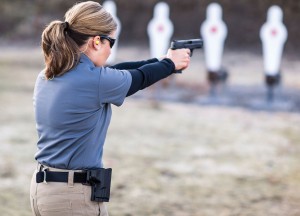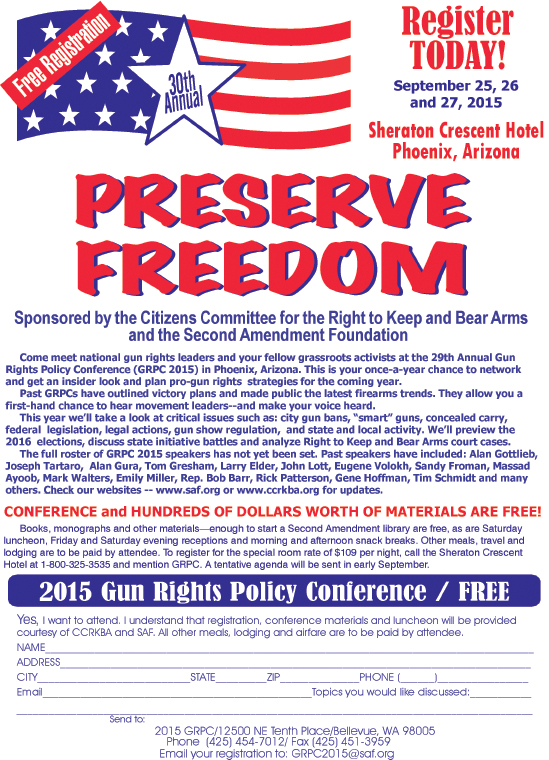By Peggy Tartaro | Managing Editor
The National Shooting Sports Foundation (NSSF) released a study titled Women Gun Owners—Purchasing, Perceptions and Participation, at the 2015 SHOT Show in Las Vegas.
The press conference for the study’s release was Standing Room Only, and dozens of people were turned away from the event.

The growing number of women maturing as gunowners has lead to growth in their numbers in shooting sports as well as increased spending by them on firearms and accessories. Photo courtesy Howard Communications.
NSSF and the study’s authors consulted with women industry members to insure that the study covered relevant topics. As might be expected from an industry-funded study, the focus was on participation in various aspects of gunownership, including shooting sports, and on respondents’ purchases.
But the picture of women gunowners that emerges from the study is one of engagement and progress. The study was conducted in 2014 among women 18 to 65 who owned at least one firearm.
Unsurprisingly, the most commonly owned firearm was a semi-auto pistol (56% of respondents said they owned at least one). Half (50%) said they owned at least one shotgun and 42% owned at least one traditional rifle, while 20% said the owned a modern sporting rifle.
On average, women in the study owned three guns and the largest proportion (42.1%) had owned at least one gun for over 10 years. A third (32.6%) are new gun owners, reporting they obtained it within the last three years.
Women who purchased a gun within the last year (37.4%) spent an average of $870. Over half (58.1%) were purchased at a local gun shop, while 42.6% were purchased at a mass retailer such as Cabela’s or Walmart.
In making a firearm purchase, the women studied consulted with family members (65%), manufacturer’s websites (54.8%), friends (51.9%) and gun shop personnel (51.8%) for information prior to their purchase.
The majority of women (67.3%) considered their purchase for at least a few month or longer before actually buying.
The study also found that women gunowners spent an average of $405 in the past year on accessories. Most of the accessories were gun care/cleaning products and basics such as targets, eye and ear protection, carrying cases, extra magazines and holsters. One in five made no accessory purchase and those surveyed said they planned to spend less on accessories in the coming year.
The single most important reason for gun ownership among the women surveyed was for defense—both self (26.2%) and home (22%). Nearly half (42.2%) have a concealed carry permit in their state of resident and 35.3% have one or more hunting licenses. Just 8% have a concealed carry permit for a state or states other than that of their residency.
While defense was the most popular reason for gun ownership, 15.3% of respondents said they purchased a gun to learn to hunt and the social aspect of wanting to go shooting with friends or family was the reason for 9.5% of those surveyed.
Nearly three quarters of the respondents (73.4%) have taken at least one training class and the women surveyed took, on average, 3.5 gun training classes. Women took concealed carry permit classes (33.3%), hunter education (32%) and range safety instruction (31.4%).
The women surveyed participate in shooting activities an average of once per month. Nearly all—95.5%—have tried target shooting and it was the one activity a majority (62.4%) continue to participate in with relative frequency—31.5% indicated they target shoot once a month or more.
Over half (57.9%) have tried hunting and 31.7% indicated they hunt frequently.
Women were also participating in practical pistol shooting, clay sports, long-range shooting and plinking. The majority were not participating in gun collecting, 3-gun and cowboy action with any consistent frequency.
The survey also was used to develop a model to predict spending on guns and accessories and frequency of participation. Unsurprisingly, the more guns owned, the more likely the participant was to both spend on guns and the more frequently they tend to participate in shooting activities.
Similarly, those with most confidence and comfort with guns and the most training, also tended to spend and participate more.
Women in the survey were more likely to have trouble with fit of both guns and apparel the more they participated in hunting and shooting activities.
Growth of the women’s market is quite visible among firearms retailers. In NSSF’s Annual Retailer Survey, more than 74% of retailers reported an increase in women customers in their stores in 2013 over 2012.




